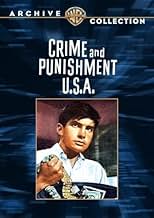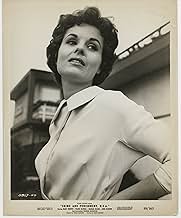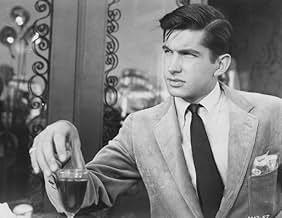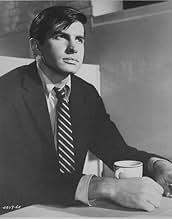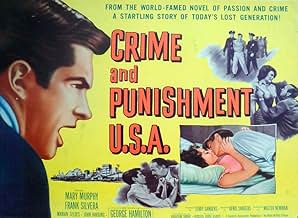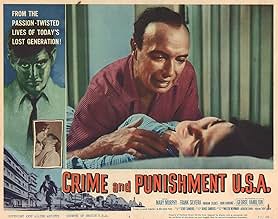Füge eine Handlung in deiner Sprache hinzuA Californian law student murders a pawnbroker, then matches wits with the detective on the case.A Californian law student murders a pawnbroker, then matches wits with the detective on the case.A Californian law student murders a pawnbroker, then matches wits with the detective on the case.
- Regie
- Drehbuch
- Hauptbesetzung
- Nominiert für 1 BAFTA Award
- 2 Gewinne & 1 Nominierung insgesamt
Tony Johnson
- Mrs. Cole
- (as Toni Merrill)
Sidney Clute
- Doctor
- (as Sid Clute)
James Hyland
- Man in Coffee Shop
- (as Jim Hyland)
Empfohlene Bewertungen
To begin with, I almost did not acquire this when I chanced upon it, since the film does not have much of a reputation; even so, it has recently been released on DVD-R as part of Warners' "Archive Collection", running 96 minutes (like the version I watched) rather than 78 as listed on the IMDb! In any case, the result is undeniably gripping (given the source material) and decidedly accomplished (in spite of the obvious low budget) – with gleaming cinematography by Floyd Crosby and a jazzy score by Herschel Burke Gilbert.
Best of all, the performances (notably, as always, the arrogant protagonist and his wily nemesis) are reasonably impressive. George Hamilton (being nominated for a BAFTA award in his film debut) kind of channels Anthony Perkins here, and it is unfortunate that he would soon forsake such thoughtful roles for sophisticated (and, in the long run, superficial) ones. Frank Silvera plays his pivotal cop role as something of a buffoon; Mary Murphy's character, then, does not shy away from discussing her sordid 'profession'; while John Harding appears as the seducer of the hero's sister. Incidentally, Hamilton's scenes with the latter two are only slightly less compelling than his confrontations with Silvera (established in previous cinematic renditions as the novel's centerpiece).
As the title suggests, Dostoyevsky's morality tale has been updated to modern-day America: curiously, it eschews the pivotal figure of the pawnbroker entirely (though we are still told why the murder was committed) – indeed, the narrative here starts off with the arrest of the painter! Still, the victim's essentially disagreeable characteristics are transferred onto the afore-mentioned Harding – which seemed unnecessary at first, but this does generate an intriguing complicity between the two murderers paid off, most effectively, in ironical fashion when the student ultimately confesses because he believes the other fellow killed himself out of remorse when it was over rejection!
In the end, the film is pretentious (boasting a powerful script by Walter Newman), with a tendency towards sleaze; that said, this mature approach is quite redolent of the transitional period in which it was made – being entrenched somewhere between studio-system Hollywood and the 'movie brats' generation. For the record, this was also director Sanders' first effort, of whose later work I have watched (and own) WAR HUNT (1962), ELVIS: THAT'S THE WAY IT IS (1970/2000) and INVASION OF THE BEE GIRLS (1973); besides, I have just acquired THE American WEST OF JOHN FORD (1971; TV) and am interested in ONE MAN'S WAY and SHOCK TREATMENT (both 1964).
Best of all, the performances (notably, as always, the arrogant protagonist and his wily nemesis) are reasonably impressive. George Hamilton (being nominated for a BAFTA award in his film debut) kind of channels Anthony Perkins here, and it is unfortunate that he would soon forsake such thoughtful roles for sophisticated (and, in the long run, superficial) ones. Frank Silvera plays his pivotal cop role as something of a buffoon; Mary Murphy's character, then, does not shy away from discussing her sordid 'profession'; while John Harding appears as the seducer of the hero's sister. Incidentally, Hamilton's scenes with the latter two are only slightly less compelling than his confrontations with Silvera (established in previous cinematic renditions as the novel's centerpiece).
As the title suggests, Dostoyevsky's morality tale has been updated to modern-day America: curiously, it eschews the pivotal figure of the pawnbroker entirely (though we are still told why the murder was committed) – indeed, the narrative here starts off with the arrest of the painter! Still, the victim's essentially disagreeable characteristics are transferred onto the afore-mentioned Harding – which seemed unnecessary at first, but this does generate an intriguing complicity between the two murderers paid off, most effectively, in ironical fashion when the student ultimately confesses because he believes the other fellow killed himself out of remorse when it was over rejection!
In the end, the film is pretentious (boasting a powerful script by Walter Newman), with a tendency towards sleaze; that said, this mature approach is quite redolent of the transitional period in which it was made – being entrenched somewhere between studio-system Hollywood and the 'movie brats' generation. For the record, this was also director Sanders' first effort, of whose later work I have watched (and own) WAR HUNT (1962), ELVIS: THAT'S THE WAY IT IS (1970/2000) and INVASION OF THE BEE GIRLS (1973); besides, I have just acquired THE American WEST OF JOHN FORD (1971; TV) and am interested in ONE MAN'S WAY and SHOCK TREATMENT (both 1964).
This is the kind of film, which you wonder how it ever got made, but in a good way. It seems to be the result of either a very low budget or some real out of the box thinking to transfer Dostoyevsky's classic to contemporary Los Angeles. Yet somehow the cinematography showing the seedy underbelly of sunny Southern California is perfectly evocative of the kind of desperation, want and need in the original novel.
George Hamilton, never a very convincing dramatic actor, does well in his first starring role as the murderer who can't resist teasing the inspector who seems to know from the beginning that Hamilton is guilty, in a plot device with another reviewer compared to Colombo. The final dénouement will be well known to readers of the novel or viewers of prior versions of the film.
The supporting cast is uniformly good, especially Frank Silvera as the police inspector and John Harding who plays Hamilton's sister's seducer. The jazz soundtrack adds to the dissonance and confusion of the lead character as he tries to evade discovery, while flirting with it at the same time. The film has a vibe similar to "Odds Against Tomorrow."
Clearly, this film wouldn't be for everybody. But I think that followers of the novel, which is still a great read whether or not, you've read it once or four times, will appreciate that whatever led the producers to transfer the setting to Southern California, and budget considerations or not, did an immense service to the novel by putting it in the glare and scrutiny of a dry, parched, California summer, where, instead of beach and sand and surf, that usually accompanies such scenery, you see desolate parking lots, cheap motels, and urban squalor as background to the characters and their melodramatic conflicts.
I think if you view this movie with an open mind, you will find it as unusual and fascinating as I did. Adaptations like this are rare enough. Of course, we are used to such stories been told on PBS with English actors with British accents playing the lead roles. Here you see that in America, we can update a classic and still keep it fascinating and current.
George Hamilton, never a very convincing dramatic actor, does well in his first starring role as the murderer who can't resist teasing the inspector who seems to know from the beginning that Hamilton is guilty, in a plot device with another reviewer compared to Colombo. The final dénouement will be well known to readers of the novel or viewers of prior versions of the film.
The supporting cast is uniformly good, especially Frank Silvera as the police inspector and John Harding who plays Hamilton's sister's seducer. The jazz soundtrack adds to the dissonance and confusion of the lead character as he tries to evade discovery, while flirting with it at the same time. The film has a vibe similar to "Odds Against Tomorrow."
Clearly, this film wouldn't be for everybody. But I think that followers of the novel, which is still a great read whether or not, you've read it once or four times, will appreciate that whatever led the producers to transfer the setting to Southern California, and budget considerations or not, did an immense service to the novel by putting it in the glare and scrutiny of a dry, parched, California summer, where, instead of beach and sand and surf, that usually accompanies such scenery, you see desolate parking lots, cheap motels, and urban squalor as background to the characters and their melodramatic conflicts.
I think if you view this movie with an open mind, you will find it as unusual and fascinating as I did. Adaptations like this are rare enough. Of course, we are used to such stories been told on PBS with English actors with British accents playing the lead roles. Here you see that in America, we can update a classic and still keep it fascinating and current.
Actually more like the previous years' COMPULSION than a modernization of Fyodor Dostoevsky's CRIME AND PUNISHMENT... although that's exactly what it is, by title, and if Frank Silvera's friendly, complimenting homicide detective is reminiscent of the 1970's TV-cop COLUMBO, both are based on the same literary character...
And ironically, George Hamilton became a victim-of-persuasion from both determined constables and here, resembling Anthony Perkins with the combined personalities of either COMPULSION killer... broodingly into Atheist philosophy while acting too good for everyone, in particular the earthy lawman... he's more aimless than guilt-ridden...
The grainy-B&W Los Angeles-set sequences between Hamilton's Robert and the affable yet clinging detective are no different in tone than existential conversations with deep-thinking heart-of-gold-hooker Mary Murphy, his best buddy (Wayne Heffney) or his sister's middle-aged fiance (seeming straight from an Actor's Studio workshop)... yet the overall stagey aspect's so upfront and natural, CRIME feels more intriguing than meandering...
And while never claiming to be a thriller, it's no melodrama either, fitting within a kind of Beatnik's soulless journey that... between the genuine street thug film noirs and the colorful counter-culture neo noirs... exists within the sharpened jazz-soaked cinema of the late 1950's, as unappreciated now as it was back then.
And ironically, George Hamilton became a victim-of-persuasion from both determined constables and here, resembling Anthony Perkins with the combined personalities of either COMPULSION killer... broodingly into Atheist philosophy while acting too good for everyone, in particular the earthy lawman... he's more aimless than guilt-ridden...
The grainy-B&W Los Angeles-set sequences between Hamilton's Robert and the affable yet clinging detective are no different in tone than existential conversations with deep-thinking heart-of-gold-hooker Mary Murphy, his best buddy (Wayne Heffney) or his sister's middle-aged fiance (seeming straight from an Actor's Studio workshop)... yet the overall stagey aspect's so upfront and natural, CRIME feels more intriguing than meandering...
And while never claiming to be a thriller, it's no melodrama either, fitting within a kind of Beatnik's soulless journey that... between the genuine street thug film noirs and the colorful counter-culture neo noirs... exists within the sharpened jazz-soaked cinema of the late 1950's, as unappreciated now as it was back then.
This is a well written script based on Dostoyevsky's "Crime and Punishment." I think it is essentially a remake of a French film, with Jean Gabin,called "Crime and Punishment," later changed to "The Most Dangerous Sin," made around the same time. At any rate, self- justification, remorse, rationalization, guilt, and Truth are the subjects at hand. Each is handled slowly, without emphasis; the viewer is expected to bring much to the picture. This explains the films lower ratings. Hamilton, as an actor, is weak, others have been reminded of Tony Perkins. He was too handsome, and wasn't smart enough to use make up or a cheap haircut to make himself appear to be the poor student of his role. But, the real star is Frank Silvera, who underplays the cagey Detective, and is a joy to watch in action. He toys with Hamilton, who, unfortunately, just isn't his match (as an actor.) Marian Seldes plays Hamilton's long suffering sister.
A young man murders an old woman for money, then relies on a sense of intellectual superiority to defeat an investigating detective.
A heavyweight subject like Dostoevski would be a challenge for the most experienced filmmaker. For the youthful crew here, however, it proves way too much. For one, Hamilton simply doesn't have the gravitas to bring off a convincing intellectual heavyweight, and that punches a hole right through the film's middle. But he's not the only one. Silvera's cagey detective makes those cat and mouse sessions with Robert (Hamilton) borderline parody. I don't know what director Sanders was telling him, but whatever it was, it didn't work. Ditto Harding's hammy wife killer that produces another regrettable result. Unfortunately, acting here means more than usual since there's so much loaded conversation. Only the two women, Murphy and Seldes, come off aptly.
On the other hand, the filmmakers certainly don't lack imagination. Adapting a bleak 19th- century Russian novel to the sunny climes of LA amounts to an imaginative undertaking, whatever the outcome. However, modifying a dense 1,000-page novel into a 70-minute screenplay would be a challenge for Dostoevski himself. Unfortunately, the effort here is like trying to pack 10 lbs. of weighty story into a 5 lb. leaky screenplay. All in all, I'm glad the Sanders brothers and Hamilton went on to more appropriate projects.
A heavyweight subject like Dostoevski would be a challenge for the most experienced filmmaker. For the youthful crew here, however, it proves way too much. For one, Hamilton simply doesn't have the gravitas to bring off a convincing intellectual heavyweight, and that punches a hole right through the film's middle. But he's not the only one. Silvera's cagey detective makes those cat and mouse sessions with Robert (Hamilton) borderline parody. I don't know what director Sanders was telling him, but whatever it was, it didn't work. Ditto Harding's hammy wife killer that produces another regrettable result. Unfortunately, acting here means more than usual since there's so much loaded conversation. Only the two women, Murphy and Seldes, come off aptly.
On the other hand, the filmmakers certainly don't lack imagination. Adapting a bleak 19th- century Russian novel to the sunny climes of LA amounts to an imaginative undertaking, whatever the outcome. However, modifying a dense 1,000-page novel into a 70-minute screenplay would be a challenge for Dostoevski himself. Unfortunately, the effort here is like trying to pack 10 lbs. of weighty story into a 5 lb. leaky screenplay. All in all, I'm glad the Sanders brothers and Hamilton went on to more appropriate projects.
Wusstest du schon
- WissenswertesThe opening aerial shots are of Pacific Ocean Park in Santa Monica, CA, a popular amusement park in the 1960s that has since closed down.
- VerbindungenReferenced in Hollywood Mouth 3 (2018)
Top-Auswahl
Melde dich zum Bewerten an und greife auf die Watchlist für personalisierte Empfehlungen zu.
Details
- Laufzeit1 Stunde 36 Minuten
- Farbe
- Sound-Mix
Zu dieser Seite beitragen
Bearbeitung vorschlagen oder fehlenden Inhalt hinzufügen

Oberste Lücke
By what name was Crime & Punishment, USA (1959) officially released in India in English?
Antwort
